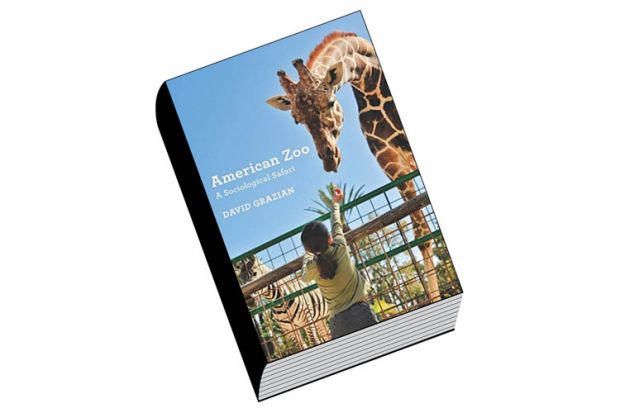Is it churlish to disapprove of the “safari” metaphor that David Grazian invokes in the subtitle of his zoo investigation?
The tradition of the safari, violently invasive and acquisitive, seems anathema to ecologically informed enquiry. Zoos today carry the burden of demonstrating that they are ecologically sensitive enterprises rather than spectacles of commodified entertainment where crowds gawk at captive inmates. Since Grazian’s conclusion posits (unconvincingly, to my mind) that zoos may indeed help motivate their audiences to be less destructive citizens of the world, his use of the safari trope seems counter-intuitive; it suggests that our ethnographer will lead us on a manfully proprietary tramp through his subject in a voracious quest for dominance.
A humbler stance towards animals and their ecosystems is more fitting in our environmentally perilous era. An ecologically beneficial institution must persuade its patrons that our unsustainable exploitation of habitats disserves the planet’s other living occupants.
In the event, Grazian’s zoo-watching isn’t egregiously imperialistic. It’s mostly an even-handed account of the years that he spent behind the scenes volunteering at two US zoos and visiting dozens more, where he observed and documented the spectators, the animals, the keepers, the executives and corporate sponsors, and even the animal rights protesters outside the gates, as they coursed through this cultural phenomenon of highly mediated encounters with displaced animals. (Typifying his thoroughness, he informs in a footnote that while feeding the inhabitants, “I took it upon myself to taste each brand of herbivore animal food that came across my kitchen scales.”)
The book resonates with ethical and polemical tensions with which Grazian mostly engages. Often the scenarios speak for themselves. A zoo educator recounts: “I was standing by the cougars, and I heard a little kid say, ‘Hey Daddy, isn’t that just like the one you shot?’” Perhaps the zoo is, after all, simply an extension of our collective cultural safari.
Readers may reasonably anticipate Grazian’s trajectory towards an anti-zoo denouement, given his keenly captured chronicles of the ridiculous things that people do in zoos (and that zoos themselves facilitate).
Zoo-goers litter rampantly, Grazian informs us; if zoos are supposed to be enlightened institutions, shouldn’t we expect them to inspire better behaviour? At one of the US’ most prominent aquariums, visitors can, after they finish looking at the marine life, eat oysters on the half shell, pink shrimp, Dungeness crab salad and clam chowder. (Customers “would often ask staff if the fish served in the cafeteria had been harvested from the aquarium’s own exhibited collection”.)
Zookeepers feed flamingos a special diet so that they will appear as pink as people expect them to be. Gift shops feature tacky plastic souvenirs “destined to wind up in local landfills”. Visitors yell at lions to try to get them to roar back as they do in films. People who own chinchilla coats say that they enjoy coming to pet the chinchillas. Spectators ask to ride the giraffes, or pet the lions, or have the penguins help them propose to their girlfriends. Grazian’s observations show audiences pervasively uninterested in, and uneducated about, these animals’ integrity: appreciating who they really are.
Alongside such microaggressions, Grazian reveals larger systemic problems, too. Many zoos receive large donations from petrochemical companies (“greenwashing”), significantly constraining their freedom to teach the consummately important lesson that wild animals suffer precisely because of our habits of consumption, our incontinent appetite for fossil fuels. Global warming is absent from the discourse.
Even evolution is censored as a topic at many zoos – too controversial! Pandering to paying customers, zoos decline to challenge their prejudices, which (I would argue) disqualifies their claims to be educational partners in the cause of animal protection.
So it comes as a surprise when Grazian tries to conclude with a happy ending, suggesting that if zoos could only stop doing everything that they’ve always been doing, they might help us to navigate a better future course. But as he himself describes earlier, zoos began to embrace conservation as “a clever organizational adaptation” designed to head off public criticism that they seemed like animal prisons. “Conservation” (a term that right-wing focus group testing found less inflammatory than “environmentalism”) is merely the zoo industry’s latest brand, a palliative that does not compel its customers to consider our own implication in the ecological morass we have created.
Randy Malamud is Regents’ professor of English, Georgia State University, and author of Reading Zoos: Representations of Animals and Captivity (1998).
American Zoo: A Sociological Safari
By David Grazian
Princeton University Press, 344pp, £19.95
ISBN 9780691164359
Published 23 September 2015
Register to continue
Why register?
- Registration is free and only takes a moment
- Once registered, you can read 3 articles a month
- Sign up for our newsletter
Subscribe
Or subscribe for unlimited access to:
- Unlimited access to news, views, insights & reviews
- Digital editions
- Digital access to THE’s university and college rankings analysis
Already registered or a current subscriber? Login




